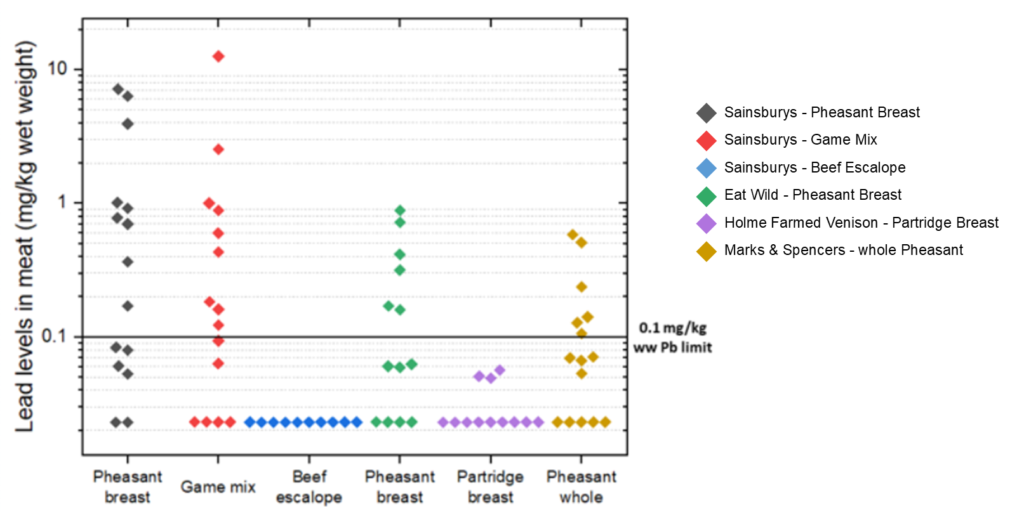Lead levels in supermarket game meat – latest results
This winter we bought game meat from supermarkets in the UK and sent the samples to be tested for lead levels by experts at a laboratory. This is the latest in a series of such examinations we have carried out with game shot in the 2020/21, 2021/22 and now 2022/2023 shooting seasons. As usual we also purchased non-game meat and had those samples tested in the same way.
We bought meat from Sainsbury’s stores in southeast England (London, Essex, Suffolk and Bedfordshire); Pheasant breasts, game mix and beef escalopes (black, red and blue diamonds respectively in the graph below).
We bought Pheasant and partridge breasts online from Eat Wild, Holme Farmed Venison (green and purple diamonds in the graph below)
We bought whole Pheasants online from M&S and picked them up before Christmas at a local store (yellow diamonds in the graph below).

The horizontal line (at 0.1mg/kg Pb ww) shows the legal maximum lead level for non-game meat. There is no legal maximum lead level set for game meat – which is totally bizarre.
You can see that the beef escalopes are all well below the line (any lead in them was below the detectable threshold of the test). That’s what they should look like and in previous years when we have tested chicken, duck, and pork then all those samples have been similarly ‘lead-free’. Good!
Also – and this is encouraging – the 12 partridge breasts bought from Holme Farmed Venison also had low lead levels. If the maximum levels that apply to pork, beef, chicken etc did apply to game meat then these samples would have been legal to sell.
However, Pheasant breasts and game mix from Sainsbury’s, Pheasant breasts from Holme Farmed Venison and whole Pheasants from M&S had some samples that were high in lead levels. When we say ‘high’, some were very high. The scale on the Y-axis of the graph is a logarithmic one so that we can fit all the data onto one graph. If we had used a linear scale then if you are looking at this on a PC the highest points would be heading for the ceiling of the room you are in!
If you consider the 70 game meat samples shown in the graph above, nine of the 10 highest values are from Sainsbury’s Pheasant breasts or the game mix bought in their stores (the other of the top ten, the ninth highest, was from the Eat Wild Pheasant breasts).
We discuss these results, and those of the analyses of game meat bought in Lidl stores in Northern Ireland, in the next blog which puts this year’s results in context with previous years’ findings.
